FREE
RESOURCES: Classroom
Activities [
Page 3 ]
Student
discussions, exercises, games before and after the play
<
Prev | 1
| 2
| 3
| 4
| 5
| 6
| 7
| 8
| 9
| Next >

This page (Page
#3) has creative activities for use in the classroom. Kids love
to learn more about the play’s origin and subject. Check
out these articles and activities related to ArtReach’s popular
titles: Wizard of Oz, Aladdin, Wizard
of Oz, Robin
Hood, We Are The Dream, Harriet
Tubman, Blue Horses, Snow White Christmas,
Sleepy Hollow, A Thousand Cranes,
Peter Pan, Winnie-the-Pooh.
Don’t forget, a Teachers
Guide will come with your School Play Package and contains tons of
creative new ideas for your teaching lessons!

What
Lessons Does ‘Wizard of Oz’ Teach Us?
Classroom
Discussions – Wizard of Oz
General
Discussion / Questions
1. Why does Dorothy want to be
in some other place than Kansas?
2. Do you ever feel like
Dorothy did?
3. Dorothy is taken to Oz by a
"twister", what is another name for a twister?
4. Oz is a very beautiful and
colorful world, but Dorothy still finds problems there. Do you think
there is any place where there are no problems?
5. Do you think the Scarecrow
really needed a brain? The Tinman a heart? The Lion his courage?
"Does
the Scarecrow really need a brain? Why?"
  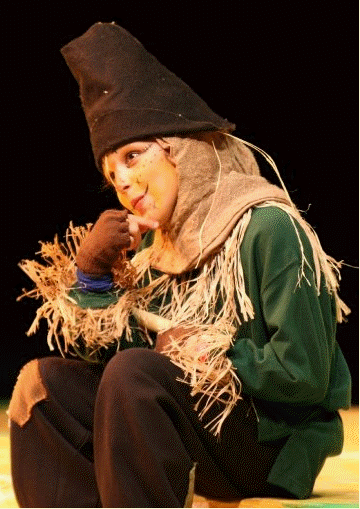
A Roaring Good Time
at Lakefront Youth Theatre Experience, New Orleans
6. The Wizard, at the end of
the play, turns out not to be a Wizard. Though he didn't have the
magic powers of a wizard, do you think he helped Dorothy, the
Scarecrow, the Tinman, and the Lion?
7. It is interesting that
Dorothy had the power to return home to Kansas anytime she wanted to
but she wasn't aware of it. Do you think we often have the power to
do what we want but we may not know it?
8. How many books have been
written about the Land of Oz? (hundreds) Have you heard of any others
besides The (Wonderful) Wizard of Oz?
Drawing &
Art Activities
You saw the Wicked Witch' s
castle, what do you think Glinda's castle looks like?
Draw a picture of your
favorite part of the show; of your favorite character.
Draw a picture of yourself
with characters in the play. Where would you be? What would you be doing?
"The
world is full of wonders." -- L. Frank Baum
 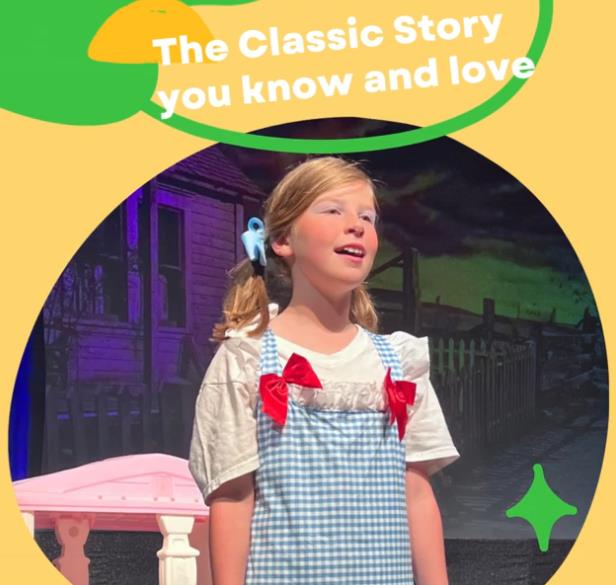 
ArtReach's
Wizard of Oz - Gaslight Theatre Kids Drama Camp, Enid OK
Famous Wizard
of Oz Quotes
Discuss what meaning these
sayings have for us in our everyday lives. Can you give an example
that illustrates the meaning?
"Never question the
truth of what you fail to understand, for the world is full of wonders."
-- L. Frank Baum
"..Remember, my
friend, a heart is not judged by how much you love, but by how much
you are loved by others..." – Wizard
"...if I ever go
looking for my hearts desire again, I won't look any further than my
own backyard... Because if it isn't there, I never really lost it to
begin with.”
-- Dorothy
History
of the Magic Flying Carpet & Camels - Classroom Material
Featuring
ArtReach's Aladdin
play for Kids to Perform
Before people would consider
space shuttles or even jumbo jets, they imagined a fantastic form of
aerial transport - a magic carpet or flying carpet. These fanciful
floorings could levitate great loads and travel at speeds then beyond
fantasy. From their beginnings in the ancient world, legends of
flying carpets have traveled across millennia and continents alike.
Origins
of the Magic Carpet:
Legend
has it that biblical King Solomon owned a huge magic carpet - at
least large enough to bring the King's entourage along. Several
hundred years later, the enchanting queen cheherazade told her
husband stories of flying carpets in Arabian Nights. Fortunately, the
queen's storytelling chops ended the king's practices of summarily
beheading his wives after one night.
People
imagined a fantastic form of aerial transport - magic carpets.
 
Ashland Childrens Theatre
(Ashland, OR) - ArtReach's Aladdin
The
Flying Carpet in Western Lore: These Eastern stories
have enchanted the West for centuries; flying carpets pervade our
popular culture today. At the end of World War II, the United States
turned its aircraft carriers and other vessels into giant floating
dormitories, dispatching them to bring servicemen home from far-flung
lands. The armed forces dubbed this effort "Operation Magic Carpet."
Late 60s rock band Steppenwolf
rocked the chart with a far-out (and perhaps pharmaceutically aided)
"Magic Carpet Ride." More recently, animated plumbers Mario
and Luigi contend with rug-riding enemies in the Super Mario Bros.
video games.
While the original Aladdin
legend has the bandit using a rug as a getaway vehicle in ancient
Baghdad, Disney's westernized Aladdin whisks his midriff-baring gal
Jasmine on a carpet-borne dream date. Sadly, this is not an option
for modern sorcerers on the dating scene; in the world of J.K.
Rowling's teen warlock Harry Potter, the Ministry of Magic has
outlawed flying carpets.
The
original Aladdin legend has the bandit using a rug as a getaway.
 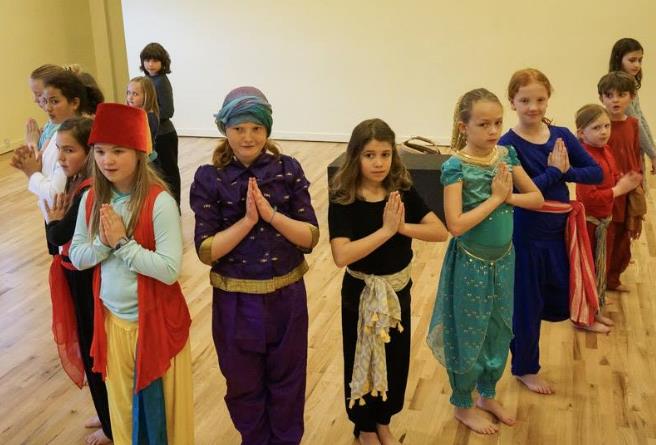 
Ashland Childrens Theatre
(Ashland, OR) - ArtReach's Aladdin
About
Camels, Creatures of the Desert: When many people all
over the world think of Egypt, they think of the Pyramids with a
graceful caravan of camels passing by. It's easy to imagine the
caravans of traders heading into the desert. With no food or water
needed for their beasts of burden, we fancy that the journey was made
easier. It is a romantic dream of many people to view such a caravan.
The truth is, by far, stranger than the myths that have grown up
around the camel, the beast of burden which helped spread wealth
around the ancient world.
One of the most enduring and
misunderstood myths about the camel is it's ability to go days
without water. Myth tells us that the camel stores water in its hump.
The truth is the hump, or humps in the case of the Bactrian camel,
are a fatty deposit that provides energy when food is scarce. When a
camel's energy reserves become low from lack of food, the hump
shrinks and becomes soft and will actually flop over to one side. The
resilient nature of the animal can be seen in the rapid return of the
hump to its normal firm upright self after just a few days of good grazing.
Imagine
the caravans of traders heading into the desert.
 
Ashland Childrens Theatre
(Ashland, OR) - ArtReach's Aladdin
The history of the camel is
just as interesting as the animal itself. Evolving in North America,
the camel apparently crossed the land bridge over the Bering Strait
during prehistoric times. After a time, camels became domesticated,
and now the only wild camels are a small population of 500-700
animals in China's Gobi desert. Asia and Africa are home to
domesticated camels only. Camels were introduced to Australia and a
few feral animals exist in the wilds there. An experiment introducing
the camel to the North American desert in the 1800's was
unsuccessful, although occasional reports of a camel sighting are received.
While having a reputation for
being an unpleasant animal, the camel is actually a friendly animal.
The grunting and groaning when rising are similar to a grunt from
humans upon lifting a heavy weight. A distressed camel will spit a
noxious stream of stomach contents, but generally a camel is a
pleasant, hard working, intelligent animal.
Lets
Talk about Courage!
The
Cowardly Lion in Wizard Of Oz
is Perfect for Discussion!
Discussion
/ Questions: Have a
class discussion about the Lion's search for courage. The following
questions could be addressed:
Why
do you think the Lion felt that he needed courage?
(Lions
are known as the King of the Jungle. The Lion felt that he did not
have enough courage to live up to the expectations of others)
Talk
About the Cowardly Lion in Wizard of Oz
 
Karapiro
School, Cambridge, NZ - British
School, Ho Chi Minh City, Vietnam
How
important is it to live up to the expectations of others, such as
parents, friends, and acquaintances? Do you feel that there are times
when you do not have enough courage? What do you do in these situations?
What
would you like to do? What is the best thing for you to do?
Was
the Wizard able to give the Lion courage at the end of the story?
(No,
he discovered that courage must come from within. As various
challenging situations arose on the journey, the Lion unconsciously
responded courageously because of his desire to help others)
"Believe
in yourself."
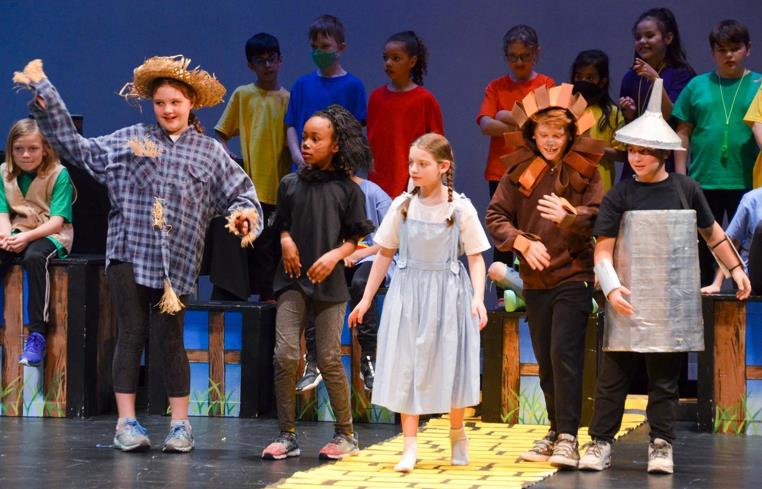
ArtReach's The
Wizard of Oz - The New School, Fayetteville AR
Ask
students to reflect upon a time they exhibited courage when they
thought that they lacked it. Have students think about ways they can
develop courage.
Writing
Exercise: Have
students write a commercial or jingle that tells/shows the audience:
How to Cultivate the Courage that Lies Within Us. Some ideas that can
be incorporated are: Believe in yourself. Don't be afraid to say no.
Telling the truth is always the best policy. Don't feel that you must
follow the crowd in order to survive. It is more important to think
for yourself.
Consider
the Origins of
ArtReach's Hero, "Robin Hood"
Did Robin Hood
really exist?
Legend has it that Robin Hood
was an outlaw living in Sherwood Forest with his 'Merry Men' - but
did he really exist?
There are several versions of
the Robin Hood story. The Hollywood one is that of an incredibly
handsome man - Errol Flynn - clothed in garments of Lincoln green,
fighting for the rights of the oppressed and outwitting the evil
Sheriff of Nottingham.
"Robin
fights for the rights of the oppressed and outwits evil."
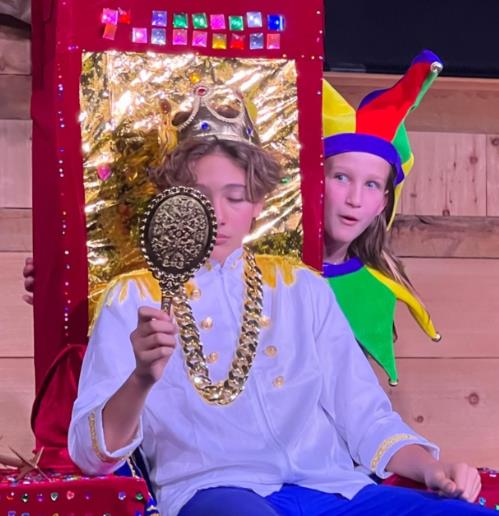 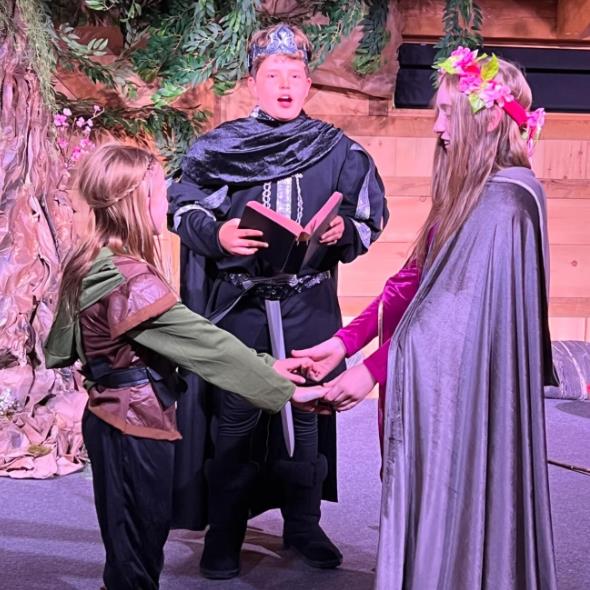 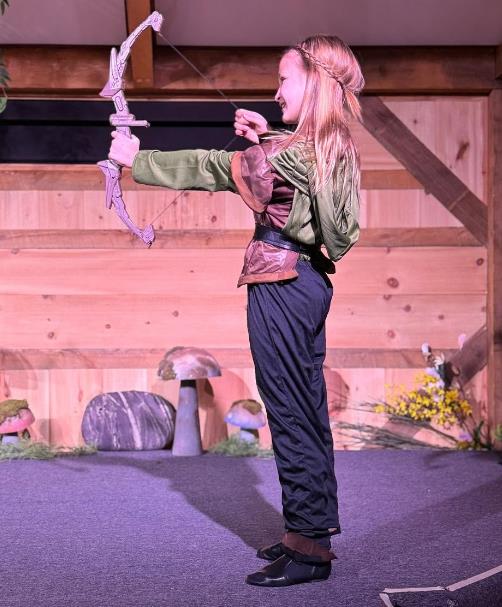
ArtReach's Robin
Hood - Princeton Junior School, Princeton NJ
One well known story about
Robin that places him in Whitby, Yorkshire, is about him and Little
John having a friendly archery contest. Both men were skilled at
archery and from the roof of the Monastery they both shot an arrow.
The arrows fell at Whitby Lathes, more than a mile away. Afterwards
the fields where the arrows landed were known as Robin Hood's Close
and Little John's Close.
Robin became a popular folk
hero because of his generosity to the poor and down-trodden peasants,
and his hatred of the Sheriff and his verderers who enforced the
oppressive forest laws, made him their champion. Some chroniclers
date his exploits as taking place during the reign of Edward II, but
other versions say the king was Richard I, the Lionheart. Robin
having fought in the Crusades alongside the Lionheart before
returning to England to find his lands seized by the Sheriff.
"Robin
became a popular folk hero because of his generosity."
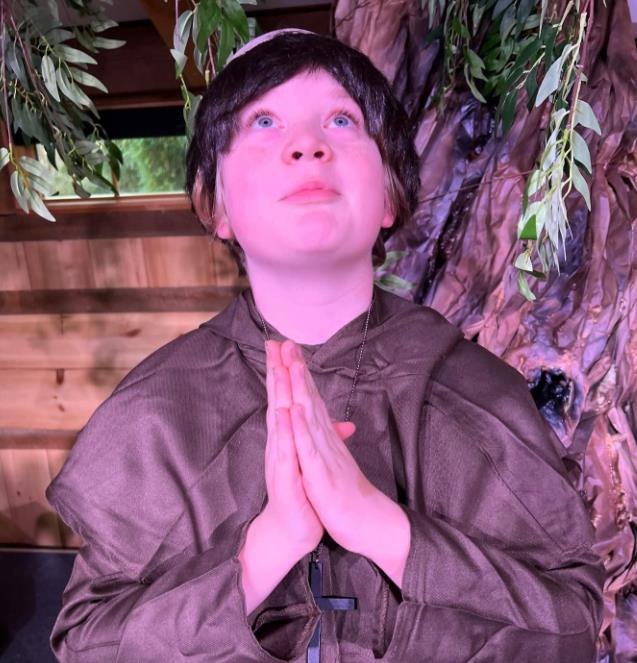 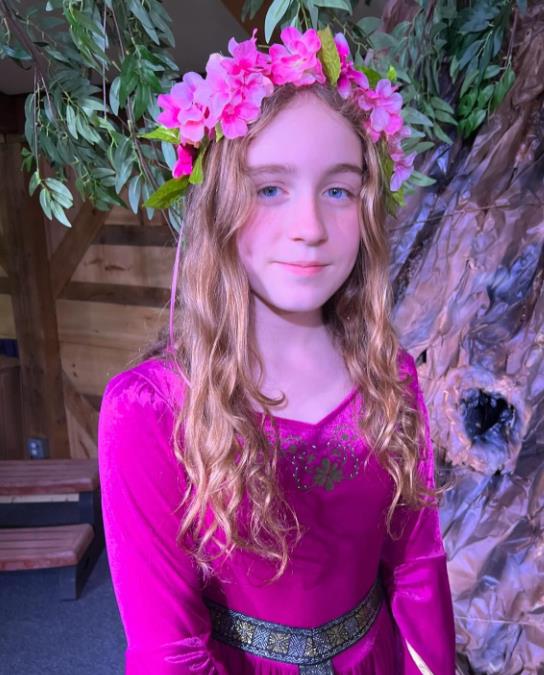 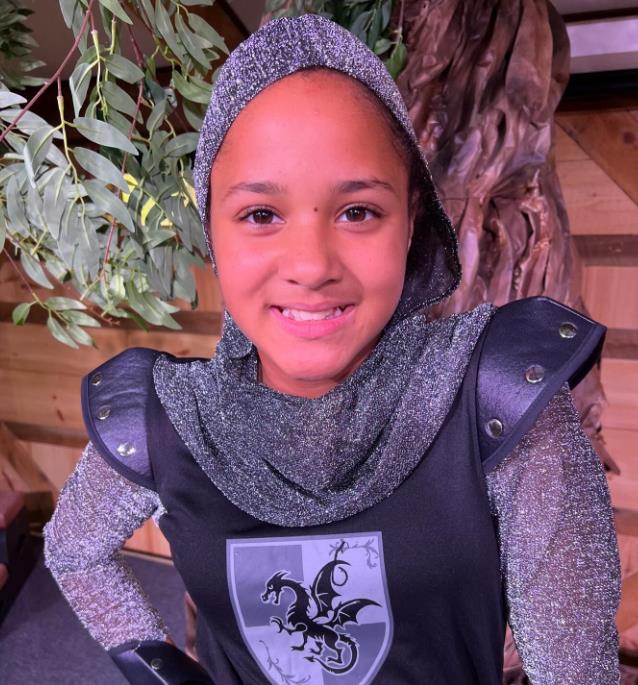
ArtReach's Robin
Hood - Princeton Junior School, Princeton NJ
All versions of the Robin Hood
story give the same account of his death. As he grew older and became
ill, he went with Little John to Kirklees Priory near Huddersfield,
to be treated by his aunt, the Prioress, but a certain Sir Roger de
Doncaster persuaded her to murder her nephew and the Prioress slowly
bled Robin to death. With the last of his strength he blew his horn
and Little John came to his aid, but too late.
Little John placed Robin's bow
in his hand and carried him to a window from where Robin managed to
loose one arrow. Robin asked Little John to bury him where the arrow
landed, which he duly did.
"One
of the best known tales of English folklore."
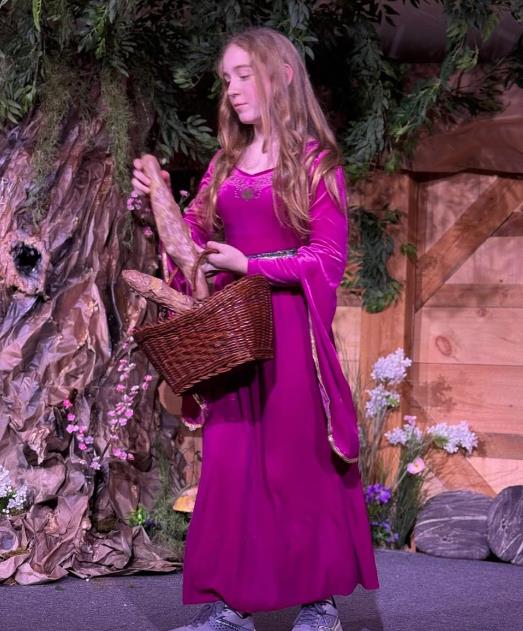 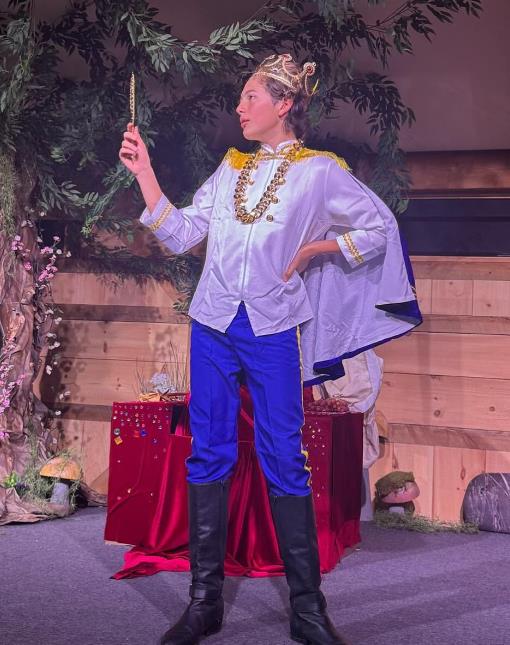 
ArtReach's Robin
Hood - Princeton Junior School, Princeton NJ
But what of his lover Maid
Marion? Not much of Robin's career is known, but nowhere in the
chronicles is Maid Marion mentioned, so we must assume she was
'added' to the stories at a later date.
So, Robin did exist, but not
in quite the same way as the Robin Hood we all think of, the
cinematic Robin of Sherwood, Prince of Thieves! His story however,
remains one of the best known tales of English folklore.
Martin
Luther King in the Classroom
Prepare
for ‘We are the Dream’
with Classroom Activities
Citizenship
/ Role Playing
This
common activity is used in classrooms everywhere – but it's one
worth repeating from time to time! The activity helps students
understand the concept of "discrimination."
For
this activity, divide the class into two or more groups. Some
teachers divide students by eye or hair color; some invite students
to select and wear badges of different colors (purple, green, and
other colors that are not related to skin color); and others isolate
students whose first names begin with the letter B (or whichever
letter is the most common first letter of students' names in the class).
For
a class period or for an entire school day, one group of students
(for example, the kids who have blond hair, those wearing orange
badges, names start with B, etc.) are favored above all others. Those
students receive special treats or special privileges, and they are
complimented often. Students who aren't in the "favored"
group, on the other hand, are ignored, left out of discussions, and
otherwise discriminated against.
At
the end of the period, students discuss their feelings.
•
How did it feel to be treated unfairly, to be discriminated against?
•
Invite students to talk about times they felt they were judged or
treated unfairly.
•
How does this experiment relate to the life of Martin Luther King?
Let
Your Kids Live the Dream!

A Student
Performs MLK's Dream Speech!
Charteret School, Bloomfield, NJ
Read
Aloud
Read
aloud one of many Martin Luther King, Jr. biographies to motivate
interest in creating a timeline of his life. Your school and local
libraries are sure to have several to choose from.
Select
a handful of the most important events from the book to start your
timeline. Let students fill in other events as they use other books
(and online resources) to learn more.
Teachers
at the lower grades might focus on books that emphasize a
"getting along" theme -- books such as The Land of Many
Colors by the Klamath County YMCA (Scholastic, 1993), Together by
George Ella Lyon (Orchard Paperbacks), and The Berenstain Bears and
the New Neighbor (about the bears' fears when a panda family moves in
next door).
Geography
On
a U.S. map highlight places of importance in the life of Martin
Luther King. Place a pushpin at each location and extend a strand of
yarn from the pin to a card at the edge of the map. On the card
explain the importance of that place.
History
/ Role Playing
Make
a list of events that are included on your Martin Luther King
timeline (e.g., Rosa Parks' bus ride, integrating Little Rock's
schools, a lunch counter protest, the "I have a dream” speech).
Let
students work in groups to write short plays in which each group
acts out one of the events.
Public
Speaking
Martin
Luther King's "I have a dream" speech is one of the most
famous and often quoted speeches of all time.
•
Read the speech aloud.
•
Invite students to listen to the speech. ( Hear
the speech )
•
Write on a chart some of the "dreams" Martin Luther King
expressed in it.
•
Ask students to think about the things they dream for themselves,
their families, their country, and the world, and to express those
dreams in their own "I have a dream” essays.
Multiculturalism
A
simple class or school project can demonstrate the beauty of diversity!
Martin
Luther King's dream was to see people of all countries, races, and
religions living together in harmony. Gather seeds of different kinds
and invite each student to plant a variety of seeds in an egg carton.
The seeds of different shapes, sizes, and colors will sprout side by side.
Once
the plants are large enough, transplant them into a large pot in the
classroom or in a small garden outside. Each class in the school
might do the project on its own, culminating in the creation of a
beautiful and colorful (and diverse!) school-wide garden.
Theatre
Etiquette - ArtReach
Plays
Here are a few
ideas for discussing etiquette with your students and young audiences:
1. Sometimes we
forget when we come into a theatre that we are one of the most
important parts of the production. Without an audience there would be
no performance. Your contribution of laughter, quiet attention and
applause is part of the play.
2. When you
watch movies or television, you are watching images on a screen, and
what you say or do cannot affect them. In the theatre the actors are
real and present in person, creating an experience with you at that
very moment. They see and hear you and are sensitive to your
response. They know how you feel about the play by how you watch and listen.
3. An invisible
bond is formed between actors and a good audience, and it enables the
actors to do their best for you. A good audience helps make a good performance.
"An
invisible
bond is formed between actors and audience."
 
Blue
Horses -- Huron High School, Sioux Falls SD -- Cast and Audience
Suggestions for
Student Etiquette:
1. You share
the performance with everyone in the audience. Your talking, movement
or any other distracting activity, once the show has begun, not only
disturbs the actors onstage but the audience around you as well.
2. Your
comments and ideas about the play are important, but save them for
after the play to discuss them. Or even better, write a letter to the performers.
3. Before
entering the performance area, get a drink of water or visit the
restroom if you need to.
4. Once you are
seated, you should remain seated. When the play begins, because the
actors are directed to move all about the room, it's important for
everybody's safety that the walkways and stage areas remain clear of students.
Harriet
Tubman: Take My Hand and Follow Me
ArtReach's New School
Play for Kids to Perform: Here's the Plot Outline
ArtReach's new play, Harriet
Tubman: Take My Hand and Follow Me, presents the true-life story
of one of America's greatest heroes. At great risk to her own life
and freedom, former runaway Harriet Tubman, traveled back to slave
country nineteen times to lead hundreds of people to freedom in the
North. She was a conductor of the Underground Railroad, the secret
network of abolitionists who helped runaway slaves escape. The play
inspires while encouraging participation from the audience in singing
the songs of freedom - a host of American spirituals.
"Oh,
who will come and go with me?"
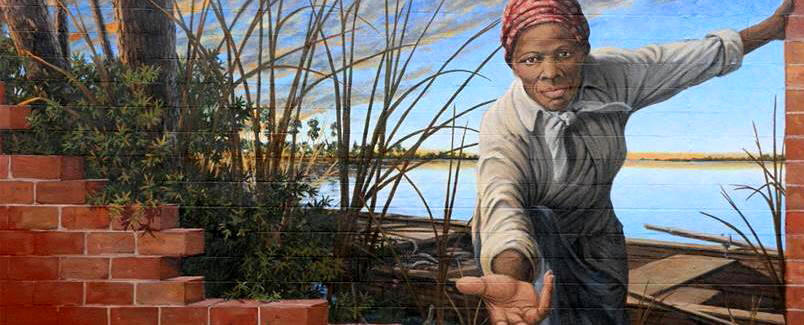
Public art mural on the
Harriet Tubman Museum and Educational Center, Cambridge, MD
The play begins with an
introduction by Storytellers which is a depiction of the moment of
escape and running. They set the scene in a frightening swamp and
forest at night. Harriet appears and tells the audience to be quiet,
just as she would tell her followers as they traveled the Underground
Railroad. She says, "Take my hand and follow me." The
Storytellers use this as a rhythm and refrain for the play and begin
narrating the story of Harriet's life.
It is 1820 and Old Rit has had
a baby in a tiny cabin, slave quarters. She sings a lullaby, "All
the Pretty Little Horses". Prompted by Preacher, the audience
sings the song with her. After the lullaby, slave neighbors visit her
and father Ben to see the newborn babe. Old Rit, whose real name is
Harriet, tells them her baby's name is Araminta. Her friends tell her
the Master will decide what she is called, probably Minty. They also
hint that Old Rit needs to secure a job in the big house for the
girl, a much easier life than work in the fields.
As time goes on, Minty appears
as a six-year-old who loves to be outside. Old Rit tells her to make
herself more suitable for house work when the Master Brodess arrives
with news. He has hired out Minty to a neighboring estate. Old Rit is
distraught that she will lose her little girl and protests that
Brodess has already sold two of her daughters. There is some relief
that Minty is only hired out and not sold south where life is much
harder than it is in the Maryland Tidewater.
"Wade
in the water, wade in the water, children..."

Old Rit sings "Sweet Low,
Sweet Chariot" as we hear of the hard life Minty is forced to
live on the Cook estate. The audience then sings along with her. At
the end of the song we learn that Minty has been released after a
year of unsuccessful hard work. Her mother and father are very happy
to have her back home. Minty and Ben take a walk in the woods where
Minty tells her father that she cannot stand to be a slave any
longer. Her father Ben implies that she must not tell him if she is
planning an escape. However, he does teach her about survival in the
swamp forest and tells her to follow the drinking gourd in the sky, a
constellation of stars that points to the North Star that will lead
Harriet on the right path. The Preacher prompts the audience to sing
"Follow the Drinkin' Gourd."
Before Minty has a chance to
escape there is an incident in the fields involving her brother John.
Master Brodess comes to tell him that he has been sold. Everyone is
aghast as Brodess tries to take him away. His wife Mary tries to stop
him. Just as Brodess is about to strike Mary and John with a rake,
Minty jumps in and is hit in the head. Minty is knocked out cold and
lays in a deep sleep for two months.
"The
North Star will lead Harriet on the right path."
 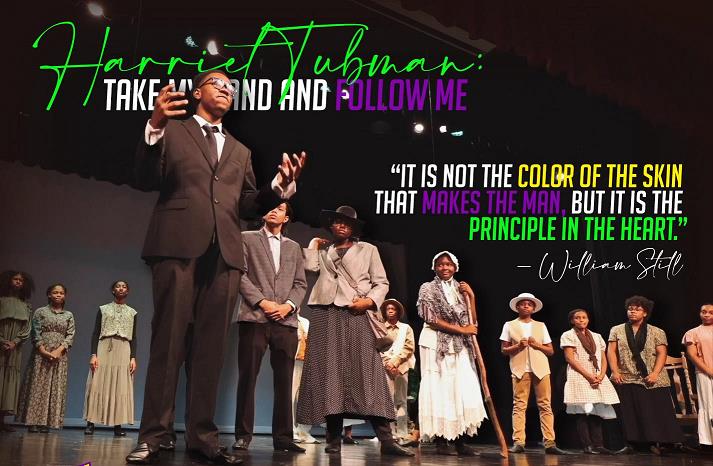
Maroon 9
Community Enrichment Organization, Fort Worth TX
When Minty awakens from her
coma she tells of a vivid dream she had. She has dreamt of a river
with beautiful ladies and freedom on the other side. She takes off
her bandage to reveal the wound on her forehead. She calls this her
Top Eye and she believes it gives her visions she needs for her
coming work. She also tells everyone that her name is no longer
Minty. She will now be known as Harriet Tubman. Soon Harriet hears
that she is to be sold south.
Harriet escapes into the swamp
forest. Storytellers recreate the scene as Harriet travels and
audience sings, "Bound for the Promised Land". Brodess is
in pursuit of her, posting a Wanted Poster for her capture and
return. But Harriet is able to elude him. After days of running and
nearly starved, Harriet encounters Mrs. & Mr. Garrett who are
Quakers and members of the Underground Railroad. The Garretts feed
her and let her rest in their home for days before she returns to her
journey. After many long arduous days, and many encounters with
Underground Railroad members, Harriet has walked a hundred miles and
arrived in Philadelphia. Harriet is finally free. Preacher prompts
the audience to celebrate by singing "Go Tell It on the
Mountain." William Still, a famous former slave himself and a
networker for the Underground Railroad, welcomes her to freedom and
introduces her to many other abolitionists.
Although Harriet is now safe
and free, everyone is astonished when she announces that she must go
back to help her family and other slaves escape as she has done.
Harriet again walks the hundred miles through swamp and forest to
find her family at Brodess' estate distraught that three of them are
about to be sold south. Harriet tells them to have courage and follow her.
"I
looked over Jordan and what did I see..."


After many days of travel the
family members are exhausted. When faced with a freezing river to
cross they lose heart and tell Harriet they are going back. This is a
decisive moment for Harriet. She orders them to follow her or die.
She tells them that no one on the Underground Railroad can ever go
back because Master will beat valuable information out of them. They
agree to cross the river. Harriet miraculously leads them across the
river to safety. She immediately slumps into a deep sleep, a
left-over symptom of the wound she received to her forehead. They
wait for her to recover and eventually follow her to freedom.
Harriet now has become the
most famous runaway slave and Underground Railroad conductor in
America. Preacher and Storytellers sing "Wade in the Water"
with its reference to Moses, the name she is now known by. One more
time Harriet returns to bring her own aging parents out of slavery.
Storytellers continue the
story of Harriet Tubman, Moses. They tell of all the people she led
out of the south and the work she did for the Union army during the
Civil War. Harriet takes the stage to tell everyone to "keep
going." Preacher notes that the river is still wide and the
journey is still going on and urges them to sing "Amazing Grace."
The play ends on a joyous
refrain of "Go Tell it on the Mountain."
"Every
great dream begins with a dreamer. Always remember, you have within
you the strength, the patience, and the passion to reach for the
stars to change the world."
-- Harriet Tubman
The
History of Santa's Elves (Elf)
Let's Talk
Elves for
A Snow White Christmas!
According to tradition, Saint
Nicholas (St. Nick, Santa Claus) has many helpers in all the
different countries around the world. While each helper goes back and
forth to St. Nick's Workshop, many live in the countries they
originate from.
In some countries where
English is the main language, these helpers are called Santa's Elves.
Each Elf , traditionally a green and red clad helper, wraps the gifts
and makes the toys in Santa's Workshop, which is located in the
Arctic North Pole.
"In
days gone by, children loved St. Nick."
  
A Snow White Christmas - Bremerton
Community Junior Theatre, WA
In days gone by, children
loved St. Nick, but were afraid of his helpers. For it was told that
is was the helpers who kept track of who had been naughty and who had
been nice. Naughty children would get coal in their stockings and may
even be carried away in the helper's bags until they learned to be good.
What can you do to help keep
an Elf from playing pranks on you on Stocking Day or Christmas Eve?
Rumor has it that if you leave a bowl of porridge out for an Elf, it
will help keep them from playing any pranks on you.
What are Elves called in other countries?
In the Netherlands, this
helper is called Black Peter.
In Iceland they are called
Yule Lads
In Germany, they are Knecht Ruprecht.
In many parts of France, the
helpers are called, Père Fouettard.
In Luxembourg, they are known
as Hoesecker.
In Nordic Countries such as
Finland, Iceland, Denmark, Norway and Sweden, an Elf will usually
only wear red, not the red and green known in English speaking countries.
In Iceland, from December 12
to December 24 the 13 the Yule Lads visit homes (a different Yule Lad
visits every day). It's during that time that the Yule Lads leave
presents and also play tricks on the children.
The
Legend of Sleepy
Hollow Classroom Ideas
Middle
Tennessee South University, MTSU Theatre and Dance, Murfreesboro
Personal
Space: Apply sensory and emotional experiences to
create a character. Each student finds their own personal space
in the room. As the teacher reads aloud the story of Sleepy Hollow,
the students act out and move with their own interpretation of the
story. There should be no interaction between students and no talking.
Walking
in Other People's Shoes: Develop movement to
express thought feeling and characterization. The teacher will
instruct students to walk around the room normally. As they are
walking the teacher will call out loud a character from sleepy hollow
(Ex. Katrina, Ichabod, Sleepy Hollow Boy, etc.) and the students have
to move about the room as if they were this character.
Halloween
Classroom Ideas: Character Study & Script Writing
 
ArtReach's The
Legend of Sleepy Hollow - Jonesborough Rep Theatre, Jonesborough TN
Character
Study: Apply sensory and emotional experiences
to create a character Students have 20 minutes to come up with a
character as a townsperson from Sleepy Hollow. They must develop
their characters and their relationship with Ichabod, Katrina, and
Brom Bones. Were they friends of Katrina? Were they one of Ichabod's
students? Were they Brom Bones' mother? Students must develop a
complete character and write a short character description on them to
turn in.
Script
Writing: Express meaning and character through
dialogue. After developing a character, students should get into
groups of 2 or 3 and write a short scene using their characters.
Allow students 30 minutes to write them and then rehearse/perform
them the next day in class.
Writing
& Speaking Activities & Literary Genres
  
ArtReach's The
Legend of Sleepy Hollow - Jonesborough Rep Theatre, Jonesborough TN
Writing
Activities: Write in a variety of modes and
genres. Have students write a story as either Brom Bones
(for the boys) or Katrina (for the girls) describing their opinion of
Ichabod Crane and how they felt about him. Be sure they write about
their opinion of his disappearance and what they think happened to
him. Have students write a business letter to a teacher
asking them to apply to be the new schoolmaster of Sleepy Hollow.
They must use vivid adjectives to describe the job requirements and
describing the town of Sleepy Hollow. Write a paragraph on the
legend of Sleepy Hollow and rearrange the sentences. Students must
arrange the sentences into sequential order.
Speaking
Activities: Continue to develop oral language
skills necessary for communication. Have students get into pairs and
interview each other. One student will be a resident of Sleepy Hollow
and the other will be a news reporter asking about the disappearance
of Ichabod Crane. They will ask questions, express reactions,
personal experiences, and opinions orally.
Literary
Genres: Experience various literary and media genres.
Explain the genre and format of playwriting, and have students write
a short script (1-2 min.) about their favorite Halloween memory.
Thanks to: Middle Tennessee
South University, MTSU Theatre and Dance, Murfreesboro
Islander
students fold 1,000 paper cranes for Japan
Mercer Island
Reporter and Sound Publishing, Inc.
Three
seventh-grade students at Islander Middle School collected and folded
more than 1,000 origami paper cranes to benefit Japan earthquake and
tsunami relief last weekend.
Three seventh-grade students
at Islander Middle School collected and folded more than 1,000
origami paper cranes to benefit Japan earthquake and tsunami relief
last weekend. Elisabeth Williams was finishing performances of
"Singin' In the Rain" at Studio East in Kirkland when she
saw two boxes filled with paper cranes. She had been making
cranes after IMS Leadership classes, as teacher Becky Mullvain and
WEB Leaders responded to a Japan relief project of Seattle's Bezos
Family Foundation. The foundation's Students Rebuild/Japan
partnered with DoSomething.org to encourage students to support
Japanese peers.
"Students
collected and folded 1,000 origami paper cranes."
 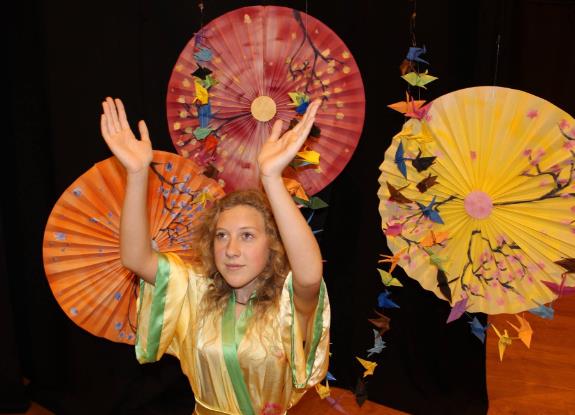
Islander Middle School,
Bellevue WA - Campanile Center for the Arts, Minocqua WI
Paper cranes will launch a
$200,000 donation from the foundation at $2 per crane with a goal of
100,000 cranes made by students worldwide. Sabrina Kwan, a
leadership student and Gillian Dewhurst, helped Williams fold many
cranes and brought the total of their efforts to over 1,000
pieces. Studio East presented "A
Thousand Cranes" in February and the cast folded cranes for
set decoration. The theater training program was eager to join in the
relief effort.
The donation will go to
Architecture for Humanity's reconstruction projects in Japan, and the
cranes will be woven into an art installation. Prepaid shipping
labels for boxes of 50 or more cranes are available by e-mailing
[email protected]. For more information, go to https://studentsrebuild.org/japan/.
A
Thousand Cranes, StudySync Grade 7
AUTHOR : Kathryn Schultz
Miller, Gender Female
QUALITATIVE
FEATURES Publication Date 1990 Genre Drama Access
Complex Text Features Genre
o This text presents a
biographical account in the form of a drama. Some sections may be
confusing unless read aloud with appropriate expression and intonation.
o Define and review the
dramatic elements for students. Read aloud passages you feel may be
confusing to students.
"Can
one young girl's story of hope inspire peace around the globe?"
  
ArtReach's
A Thousand Cranes - Children's Museum & Theatre of Maine, Portland
ORGANIZATION
o Students may be confused by
the storytelling device of the play, in which Sadako is telling her
own story and when she dies and is able to continue telling her story
with her grandmother.
o Encourage students to read
carefully as they may become confused because the dialogue weaves
between past and present. Prior Knowledge.
o The story is set in Japan in
the years following World War II, and students may be unfamiliar with
the historical or Japanese cultural references.
o Explain some of the
historical references, including World War II and the atomic bombings
of Hiroshima and Nagasaki.
READER AND TASKS
Skill Lessons Character,
Dramatic Elements and Structure Close Read Prompt Discussion: The
Giver, Nothing to Envy, and A Thousand Cranes all feature people in
complicated societies. What do these three texts suggest about the
relationship between the individual and society? To prepare for your
discussion, use the graphic organizer to write down your ideas about
the prompt. Support your ideas with evidence from the text. After
your discussion, you will write a reflection.
"Display
the cranes in the classroom or let kids take them home."
  
Folding Origami Cranes -
Academy at the Lakes, Land o' Lakes FL
BEYOND THE BOOK
Beyond the Book Activity
Origami: Folding Cranes Have students decide on a goal. Provide paper
and instructions for making cranes. Demonstrate how to fold the
cranes. Have students fold the paper into cranes. Display the cranes
in the classroom or allow the students to take them home.
To reflect, ask students:
o What else can you do to
achieve the goal?
o How will the cranes inspire
you to work toward your goal?
UNIT CONNECTION
Connect to Essential Question
Kathryn Schultz Miller, author of "A Thousand Cranes,"
tells the story of Sadako Sasaki who was two years old when the
atomic bomb dropped on Hiroshima and twelve when she became ill with
"radiation sickness" from the bomb. Believing it would help
her get well, she hoped to fold a thousand paper cranes. How can one
young girl's story of hope inspire peace around the globe? Connect to
Extended Writing Project If students enjoyed reading this play,
encourage them to choose this work to critique for their Extended
Oral Project.
IMAGINATION:
A World That Never Grows Old
Classroom
Talking Points for
ArtReach's Peter Pan
Objective:
Help students understand the importance of imagination, creativity
and the creative arts - for everyone, children and adults alike. Like
Peter Pan, it's a world that never grows old.
Activities: Have
the class reflect on the familiar story of Peter Pan.
Ask students to write a summary of the story (50-100 words).
1. Allow students to read
their summaries to the class.
2. Ask students to draw their
favorite character or scene (and tell why they picked that character
- can combine with summary story, above - helpful in assigning roles
in theplay!).
"Do
you think there's actually a magical place like Neverland?"
  
ArtReach's Peter
Pan -- Bremerton Junior Theatre, WA
3. Display all the drawings
(great as a guide for costume and set design!).
4. Ask students to name (or
draw) the "real life" characters (Wendy, her brothers, John
and Michael, her Mother and Father, their dog, Nana). Ask
students to name (or draw) the "imaginary" characters from
Neverland (Peter, Tinker Bell, Stars, Lost Boys, Tiger Lily, Indians,
Captain Hook, Smee, pirates, crocodile, etc.).
5. Never
grow up and to live in an imaginary - make-believe - place like
Neverland: What would happen if you never grew up, never
got older? (You'd be in this same class forever! No more
birthdays! Nor birthday presents! Your friends would get older,
graduate, go away, you'd still be a kid! Etc., etc. This can be
fun.) Why do you think Peter Pan never wanted to grow up?
(On the day he was born his parents told him all the things he would
have to do when he grew up - so he ran away from home! Now, that's
pretty imaginative!)
"What
would happen if you never grew up, never got older?"
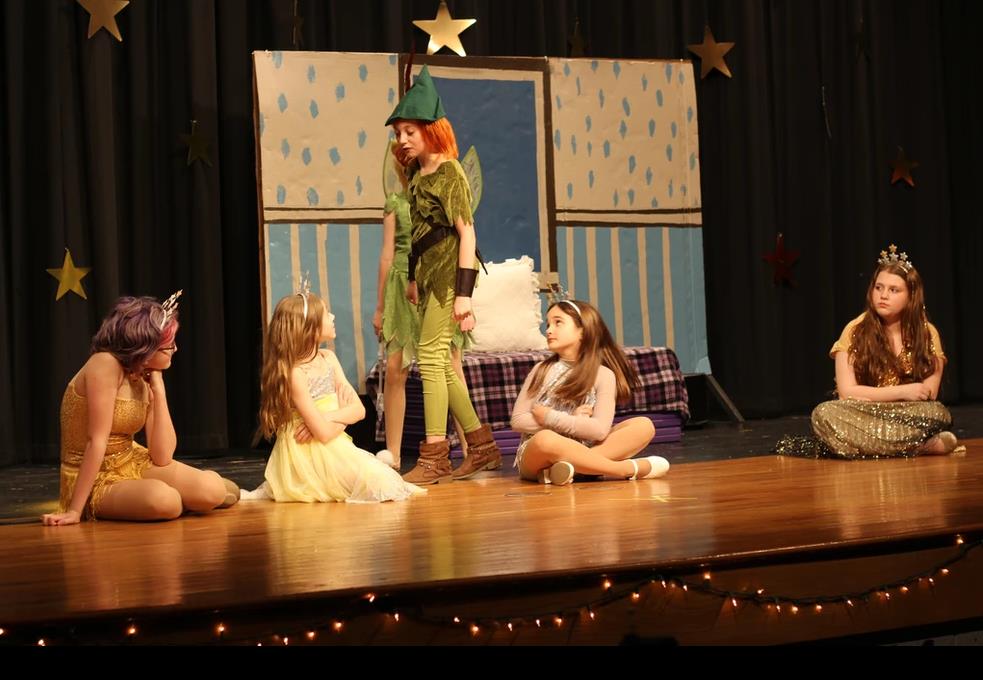 
ArtReach's Peter
Pan - C-pac Theatre Company, Columbiana, OH
6. Do you think there's
actually a magical place like Neverland? (There was for Peter Pan!
Neverland is an imaginary place created by the man who wrote the
story, J. M. Barrie. Even Peter Pan and all the people in the story
are imaginary. But isn't imagination a wonderful thing? Without it we
wouldn't have wonderful stories like Peter Pan, the Wizard of Oz, Cinderella.)
7. Can you think of your own
magical place? What would you call it? (Magicland? Fantasyland?
Funnyland? Weirdland? Darrelland, Meaganworld?)
ArtReach's
New
Play for Kids to Perform: "Winnie-the-Pooh"
SYNOPSIS OF THE PLAY
ArtReach's new play, Winnie-the-Pooh,
presents A. A. Milne's 1926 book, Winnie-the-Pooh.
It is a faithful retelling of the original book by the same name.
Most of the stories that appear in the book are performed in the
ArtReach play involving the characters of Christopher Robin, Pooh,
Rabbit, Piglet, Owl, Eeyore, Kanga and Roo. The characters of
Rabbit's Friends and Relations are briefly referred to in the book
and are here brought to life as the Storytellers.
The play begins when Mr. Milne appears trying
to work out the details of his new book. Storytellers arrive and
dress as their animal characters as they tell him they will help him
with the story. Mr. Shepard appears, seeming to be swept up in the
story by the power of his imagination. The Storytellers provide him
with the map of "100 Aker Wood (or The One Hundred Acre Wood).
Just as they put the map up, the characters of the story seem to
spill onto the stage. Christopher Robin shows up carrying his toy
stuffed bear and asks for a story. Everyone is willing to oblige and
the play the begins.
The Map of
"100 Aker Wood"

ArtReach's Children's Play
Script: Winnie-the-Pooh
Once Upon a
Time: Storytellers announce the first story by putting
up a sign that reads: "Once upon a Time". Winnie-the-Pooh
enters and hears some bees buzzing which make him hungry for honey.
He tries to climb up to the bee hive to get some but falls a long
way. Christopher Robin enters and provides a balloon for Pooh to fly
up to the hive. But the bees buzz around so much Christopher Robin
must pop the balloon with his slingshot. Down falls the bear and all
his dreams of honey.
Rabbit's House:
The next story is "Rabbit's House" Pooh visits Rabbit who
is hospitable enough to give him a large amount of honey. So much
honey in fact, that when Pooh tries to leave he has grown so fat he
gets stuck in the door or "rabbit hole" of Rabbit's house.
Christopher Robin and all the animals of forest are needed to pull
Pooh out of the hole. Once he is free Pooh goes happily on his way.
"Storytellers
arrive and dress as their animal characters."
 
Young cast rehearses - Stage
One of Richmond Civic Theatre, IN
Piglet's
House: "Piglet's House" is the next story in
which Pooh goes to visit his piglet friend and they dream a up a
scheme to catch a creature they have heard of by the name of
"Heffalump". They decide to dig a Very Deep Pit for the
creature to fall into. They decide they need a jar of honey to use as
bait and Pooh goes home to get the honey while Piglet digs the pit.
However, when Pooh gets the jar he is tempted to eat the honey. Pooh
eats so much of it that there is little left for the trap. However,
Piglet and Pooh leave what is left in the pit and go home to bed
expecting to see a Heffalump in the morning. In the night Pooh dreams
of a Heffalump eating his honey. He goes to the pit to get it and
gets the honey jar stuck on his head. When Piglet sees him in the
morning, he thinks Pooh really is a Heffalump until Pooh breaks the
jar and Piglet sees it is just Pooh. Everyone laughs at the mix-up as
Christopher Robin tells them how much he loves them for their silliness.

ArtReach's Children's Play
Script: Winnie-the-Pooh
Eeyore's
Tail: The next story "Eeyore's Tail" begins
when Pooh notices that Eeyore is missing his tail. He goes to Owl for
advice on what to do. While visiting Owl, Pooh notices that the tail
is being used as a doorbell pull. Owl admits he found it in the woods
and Eeyore can have it back. Pooh takes the tail back to Eeyore and
Christopher Robin re-attaches it. Eeyore is very happy to be reunited
with his tail.
A Very
Strange Creature: "A Very Strange Creature"
is the name of the next story referring to Kanga and Roo, a mother
and child animal that has come to the forest. Rabbit cooks up an
elaborate scheme to capture Roo thereby banishing the creatures from
the forest. When Kanga and Roo are in sight, Pooh distracts Kanga as
Rabbit grabs Roo and Piglet jumps in Kanga's pouch. But Kanga is onto
their scheme and decides to teach Piglet a lesson by giving him a
good bath and medicine. When Christopher Robin shows up, Piglet runs
away to hurry up and get dirty again.
Time to Party:
The last story is entitled "Time to Party" since it is
indeed Eeyore's birthday. Christopher Robin gets the idea to give
everyone a party to celebrate everything they've ever done. Word
spreads throughout the Wood and all the animals come for a fun time.
After everyone has celebrated Christopher Robin bestows a great honor
on Pooh; he gifts the bear with his Pencil Case. Everyone is
impressed with this great honor and they go home to bed.
Christopher Robin goes home to bed and talks to
Mr. Milne again as he holds his toy stuffed bear. He explains to Mr.
Milne that he gave Pooh his pencil case because it was such a
favorite thing of his own. He asks Mr. Milne if Pooh will always be
with him and Mr. Milne assures him that Pooh will come to him any
time he calls. They say goodnight to each other as the play and
Milne's wonderful book come to an end.

"When you go after honey
with a balloon, the great thing is
to not let the bees know you're coming."
-Winnie-the-Pooh
Classroom
Activities Page 3:
<
Prev | 1
| 2
| 3
| 4
| 5
| 6
| 7
| 8
| 9
| Next >
All
Free Resources
|